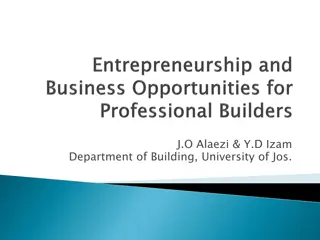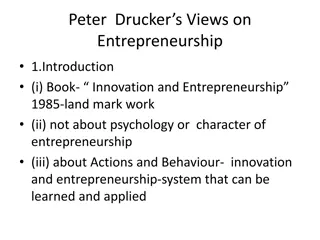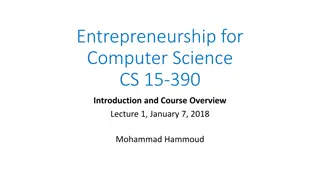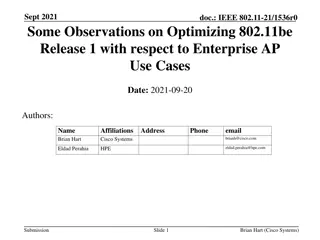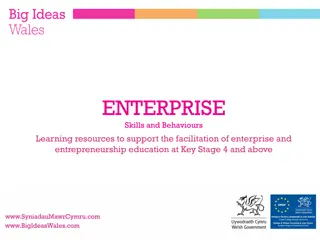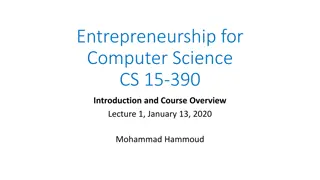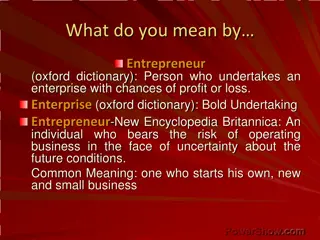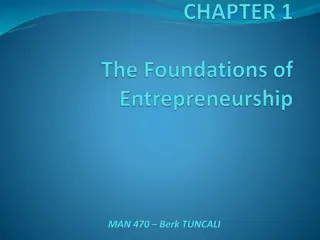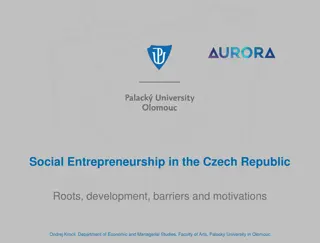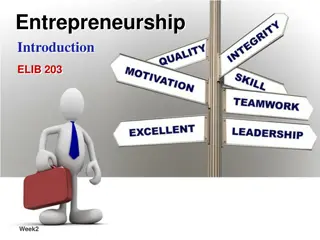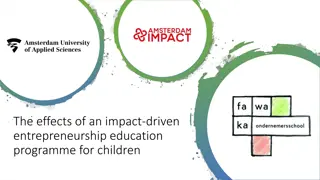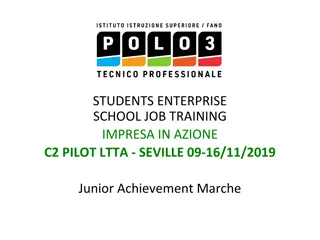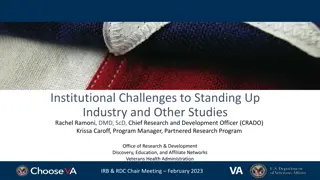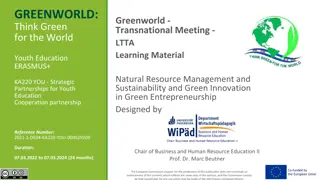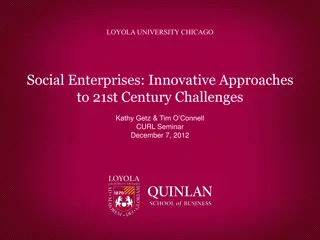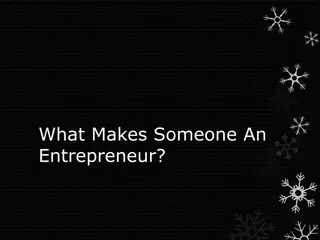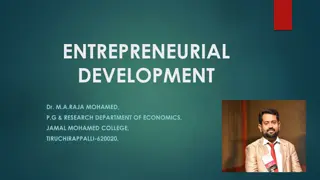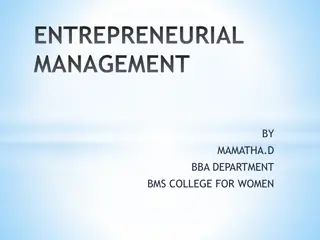Facilitating Enterprise and Entrepreneurship Education at Key Stage 4 and Above
Learning resources are provided to support the facilitation of enterprise and entrepreneurship education for students at Key Stage 4 and above. The resources focus on developing skills such as idea generation, research, presentation, communication, and managing risk. Various activities and tools are suggested to guide learners in exploring potential business ideas, conducting market research, and presenting their findings. Emphasis is placed on nurturing creativity, critical thinking, and practical application in the context of entrepreneurship education.
Download Presentation

Please find below an Image/Link to download the presentation.
The content on the website is provided AS IS for your information and personal use only. It may not be sold, licensed, or shared on other websites without obtaining consent from the author.If you encounter any issues during the download, it is possible that the publisher has removed the file from their server.
You are allowed to download the files provided on this website for personal or commercial use, subject to the condition that they are used lawfully. All files are the property of their respective owners.
The content on the website is provided AS IS for your information and personal use only. It may not be sold, licensed, or shared on other websites without obtaining consent from the author.
E N D
Presentation Transcript
ENTERPRISE Skills and Behaviours Learning resources to support the facilitation of enterprise and entrepreneurship education at Key Stage 4 and above
Entrepreneurship Characteristics: Ideas Generation Research Presentation Communication Managing Risk How do we generate ideas? Objective: To enable learners to generate ideas based on research and creativity. Introduction: This activity involves learners considering potential ideas for their enterprise. They will need to think about the feasibility of ideas in relation to their own limited resources and carry out market research to be able to justify their decisions. Encourage learners to question: Which idea, when developed, is most likely to result in success? Curriculum Links: WBQ EES Activity: 1. Using the Facilitator Help Card, introduce the idea of exploring a variety of potential options and the importance of deciding on an appropriate activity for their enterprise. 2. Learners use the Criteria & Ranking Sheet to prioritise the criteria for selecting a product and/or service. 3. Using the Products & Services Ideas Sheet, learners research different products and services and draw up a shortlist of options. Using the Holding Effective Meetings Sheet, learners could hold a team meeting to evaluate their ideas against their criteria and to action plan for what need to be done next. 4. Using the Market Research Sheet learners explore different market research methods and create their own questionnaires, forms, templates etcetera in order to ensure their chosen product/service has a potential market and is viable. 5. Learners develop a five minute presentation to include an evaluation of their market research findings. This could be presented to an appropriate audience e.g. tutor, a teacher, head teacher or a visitor, such as a Business Advisor or other invited guest. 6. Learners should file the meeting minutes with action points as evidence. Provided Resources: Product and Services Sheet Holding Effective Meetings Market Research Sheet Facilitator Help Card Criteria and Ranking Sheet Other Resources: Presentation equipment e.g. ICT / flip charts Business Advisor Learning Outcome: Learners are able to understand the importance of research in developing creative ideas. Plenary: Following the presentations, lead a group feedback session to gather together learner suggestions as to how their selected products or services may be further refined. Lesson Plan
How do we generate ideas? Ideas. Idea Generation The starting point for most new businesses is the idea. What you want to do, or what you want to sell. An innovative solution to an existing problem Opportunity developed elsewhere that you are able to copy/pursue (No IP). The idea maybe related to your studies, hobbies, work or outside of your interests. Improvement to an existing product Questions to ask as the ideas develop: ? Does it work and will it keep working? ? Can you do it by yourself or will you need help? ? Will sufficient people buy/use it? ? Do you know what your competition is? ? Is it better than the competition? ? Do you know what prices you can charge? ? Can you sell it at a price worthwhile to you? ? Do you know what benefits you are providing? ? Have you tested your idea in the market? ? Is it safe, is it legal? ? Do other people think it s worthwhile? ? Is location important? A new approach to a problem which may be a major development Opportunity created through scientific research IDEA An innovative product for which no comparison currently exists (less likely) Opportunity found by living or experiencing a problem Define the USP what will make your idea different from and better than your competitors. Opportunity created by macro trends Handout
How do we generate ideas? Ideas for products; goods, services, events or attractions. Product Goods : Goods are tangible items that are produced, bought or sold to meet the need or wants of a customer, which could be an individual or another business. Produce a product: Can you produce a product that people want to buy - toys, candles, toiletries? Do you know anyone who can sew? Can you upcycle unwanted items? Can you sell on designer labels having bought them from a charity shop? Is Christmas or Valentine s Day coming up? Product - Service: A service is an intangible activity that satisfies a need or fulfils a demand of an individual customer or another business. Offer a service: What are your skills? Can you create a jobs list and sell your services; mowing lawns, painting nails, face painting, cleaning windows, babysitting, shopping for the elderly/disabled/mothers with young children, providing IT support, showing people how to use social media. Event: An event is a planned public or social occasion and can include budgeting, scheduling, site selection, acquiring permits, coordinating transportation and parking, arranging for speakers or entertainers, arranging decor, event security, catering and emergency plans. Run an events management company: Do you know anyone who needs help to arrange or organise an event? A wedding, party, fund raising activity, sporting event, christening or band night. It could be a friend, family member, local business or charity. You could hold functions in a community hall or local hotel. Attraction; An attraction is a place which draws visitors by providing something for leisure, pleasure, interest, adventure and/ or amusement. It can be of cultural value, historical significance, natural or built beauty. Ideally it should have qualities and features that encourage revisits. Create a unique attraction: Are you artistic? Could you create a sculpture for your local town or village that would encourage visitors to the local area. How could it make money? Could you set up a pop up shop? Have you got anything to sell? Is there a gap in the market? You need to think creatively and innovatively in order to generate curiosity. Handout
How do we generate ideas? Product and/or Service Ideas: Explain the importance of potential products and services being creative innovative or meeting customers needs. Invite learners to discuss how ideas might be more successful if they balance creativity with appropriateness. You could introduce ideas generation tools/strategies; Brainstorming, Belbin s Thinking Hats, SCAMPER. Using the Products and Services Ideas Sheet, learners research some examples of possible products and services. Using the Effective Meetings Sheet, learners could hold a meeting to discuss what needs to be achieved throughout this activity and to review any action points from their previous meeting. Learners discuss the pros and cons of each idea and suggest alternatives if necessary. Careful consideration should be given to the type of activity the enterprise requires particular attention should be paid to feasibility, especially with limited set up costs available. Learners draw up a short list of possible ideas, which they will need to research further before making their final decision. Facilitator Help card
Diamond Ranking Method: Discuss and create a list of important criteria that will help your project team to decide which idea to support. When you have agreed your list of criteria, you will need to rank them. This can be achieved by using the diamond ranking method below. As a team, discuss and negotiate the relative priority of each criterion. Place the criterion in a diamond of priorities; e.g. The least important criterion is placed at the bottom of the diamond and so on. Continue to move the criterion around the diamond formation until each team member is satisfied with the ranking. TOP 1. 2. 3. 4. 5. 6. 7. 8. 9. BOTTOM Worksheet



